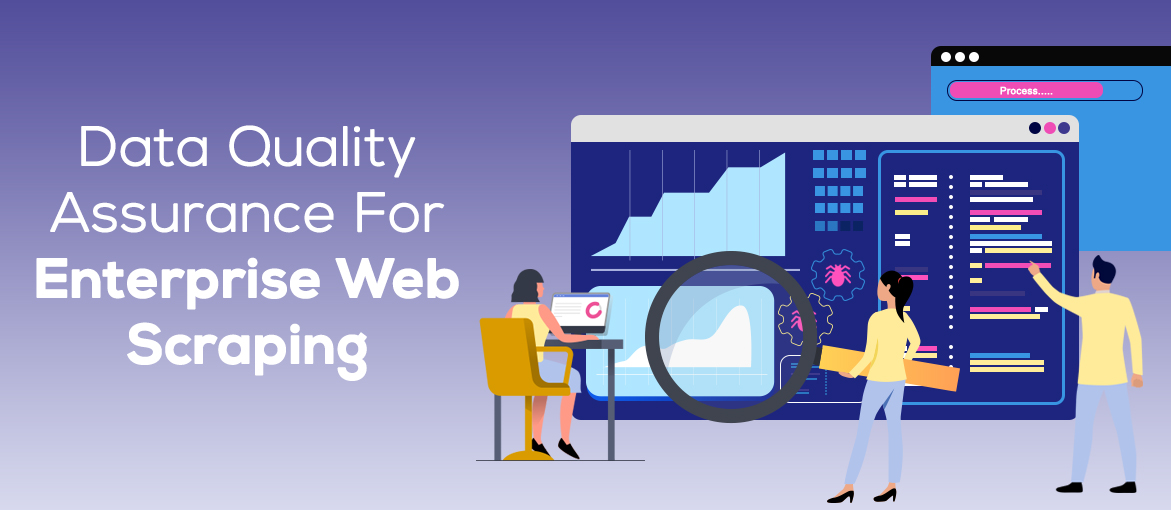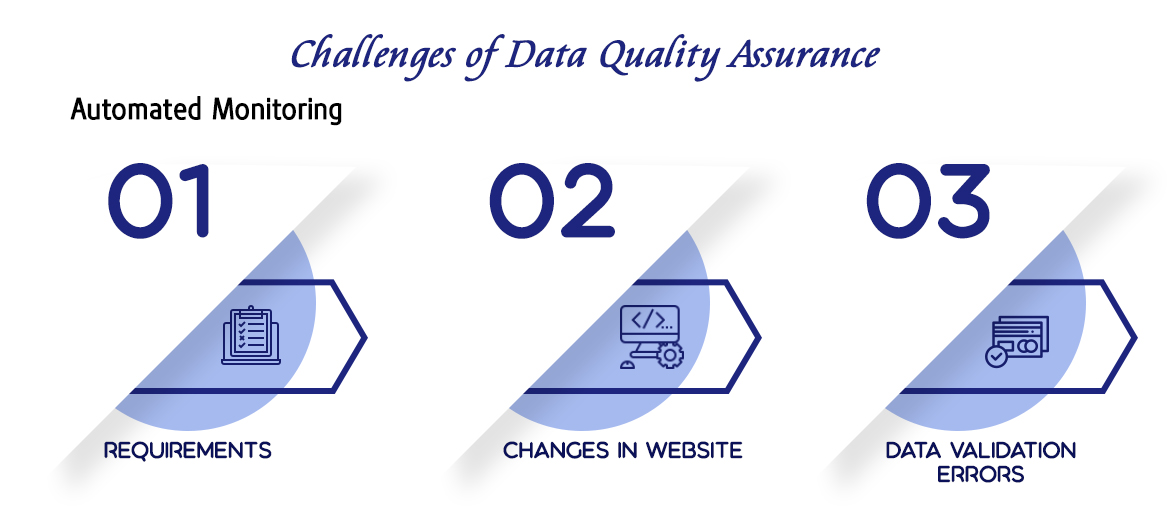
When it comes to web scraping, one major factor always leaves behind until it affects your web scraping service.
That’s Quality Assurance or Data Quality
The whole process or project of web scraping could be easy for any web scraping service provider. But to provide consistent quality data becomes a success story of that web scraping company.
The demand for high-quality data is increasing along with the rise in products and services that require data to run. Although the information available on the web is increasing in terms of quality and quantity, extracting it in a clean, usable format remains challenging to most businesses. Having being called a sustainable web scraping company from almost last the seven years, we have come to identify the best practices and tactics that would ensure high quality data from the web.
Data quality can create a huge impact on the project while delivering to the customer or giving your business a huge competitive edge in a market.
At X-Byte Enterprise Crawling, we not only talk about the strategies or process, but we ensure to provide quality data – clean and structured data. Let us give you a glimpse of data quality assurance for web scrapers. Our QA process ensures us to give quality data and coverage guarantees.
Why is Data Quality Important?
When it comes to web scraping project in any sector, the data quality plays the most important role for any extracted data. Without a consistently high quality data feed, no other web scraping project will help your business achieve its desired result and outcome.
The better the data quality, the more confidence users will have in the outputs they produce, lowering risk in the outcomes and increasing efficiency. In this data-driven world, it’s easier than ever before to find out key information about current and potential customers. This information can enable you to market more effectively, and encourage a loyalty that can last for decades.
Scraping emphasizes the importance of data quality. However, the poor data or unstructured data in a small scraping project can be managed though not suitable. But when you are scraping millions of data and pages from the web, even a small drop in accuracy or coverage could have a huge impact and consequences for your business.
While following the web scraping process, you always need to think about how you will be able to manage high quality data.
Challenges of Data Quality Assurance
Here are major three reasons for companies to deploy browser fingerprinting.
We all know that it’s critically important to extract and deliver quality data to your business. But before reaching high-end quality data, there are several challenges the company has to face. That makes a complex process.
Automated Monitoring

1) Requirements
The most important factor in any project must be requirements. Without knowing what data you require, what the final data should look like and what accuracy level you require, it’s very difficult to verify the quality of your data. Several companies approach us without having any clear requirements, but we work hard for clients to define the actual requirements.
2) Changes in Website
The several changes in website may cause poor data coverage. Due to irrelevant structure and changes in website, the data you get or deliver is poor. With the increasing of seasonal promotions, regional variations, look-and-feel, large websites make their small modification in the structure of their web pages that can break web scraping spiders. So, as a result, when you extract the data, the crawler doesn’t understand the new structure and it fetches the data as per the old structure.
3) Data Validation Errors
Every data point has a defined value type. Let’s give you an example; one data point has ‘Price’ value. It must contain a numerical value. So now if the website changes, there can be class name mismatches that might cause the crawler to extract wrong data instead of the right one for that particular field. Our monitoring system will check if all the data points are associated with their respective value types. If any mismatch or inconsistency found, then system will send an alert to the team members about this issue on an immediate level. And then issued will be fixed on an urgent basis.
Manual QA Process
1) Semantics
It’s a quite challenging task for automated QA to verify the semantics of textual information or scrape the meaning of the data. While we are developing technologies to assist in the verification of semantics of the data we extract from websites. As a result, manual QA of the data is often required to ensure the accuracy of the data.
2) Crawler Review
Crawler setup is an important factor while data extraction projects. The quality of the crawler code and its stability has a direct impact on the data quality. Our experienced technocrats do programming to make a high-quality crawler. Once the crawler is made, our expert reviews the code to make sure that the optimal approach is used for extraction and code has no issues.
3) Data Review
The data comes in a form when crawler is run. Firstly, our tech team check the data manually and then it forwards to the supervisor. This manual data check is enough to weeds out any possible issues with the crawler or the interaction between the crawlers and websites. If any issues are found, the crawler intimate to the developer to fix it before the setup is complete.
4) Data Cleansing
When the data is crawled, it may contain unnecessary elements or data tags like HTML. This may cause damage too in a data structure. Our data cleansing service does a phenomenal job by eliminating unnecessary elements and tags. Then you get the final and clean data without any of the unwanted elements.
Web Data Extraction with a Focus on Data Integrity
We will use Python and the BeautifulSoup library for web scraping. Make sure to adjust the code according to your requirements and preferences.
Best Practices for Ensuring Accurate and Reliable Data Using Scraping
Keeping in mind that all of this information differs from having a thorough understanding of the website you wish to scrape, we will now go over best practices for guaranteeing dependable and accurate data. Make sure your data is precise and prepared for analysis by adhering to the recommended practices described below.
1. Site Overview/Overview of Your Target Website
Start with a site overview to learn how the website functions, what information you wish to scrape, and how the website is organized. Using a site crawler is an excellent approach to accomplish this. You may compile all the necessary information using a site crawler without understanding how the website functions or what data points can be updated.
2. Test Your Site
Before beginning the process, it is imperative to ensure the website can be successfully scraped. Utilizing a proxy tool like Firebug can let you find any problems before scouring the website, which is the ideal method. In some circumstances, it is beneficial to conduct a web search using phrases on your target website and carefully examine the results since they might disclose helpful information.
To be able to foresee the majority of the challenges affecting your data collection process, you will need to test your site from several places.
3. Set Up Schema and Scraping
It’s time to put up your schema code once you understand how the website functions and the data you intend to obtain. Scraping data from web pages can be done using a variety of code types. In this instance, we’ll use Python’s Structured Query Language (SQL). When setting up your database table, take the following actions:
a) Create a new database table (you can call it “database”). The table must contain the first_name and last_name fields with default values (“John,” “Doe”).
b) Create a second table, then name it “scraped_data.” This table will store the contents of each web page we scrape (for example: “John Doe – Scraped Data”).
c) The output of our validation procedure will be stored in a third table, which we will create and rename to “validated_data” before the data is saved to your database. We will store two variables in this scenario (first_name and last_name), which we will then use in the code for our final analysis.
4. Crawl and Scrape the Website
The most crucial step is to crawl and scrape the website, which can be done in a few simple steps using Python.
5. Verify Your Results
Before using it and storing it in your database, make sure the data has been successfully scraped. Run this code to confirm your findings:
Conclusion:
Scraping websites is often used in data analysis because it saves time, cost, labor, and human error. This article breaks down the process into steps to help you get your hands dirty and implement your solution without prior experience. This guide will help you avoid common pitfalls when scraping websites; however, breaking the rules and experimenting are vital parts of the data science process. Try out different ideas to improve your scraping technique!
